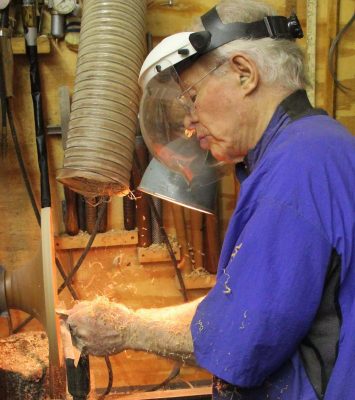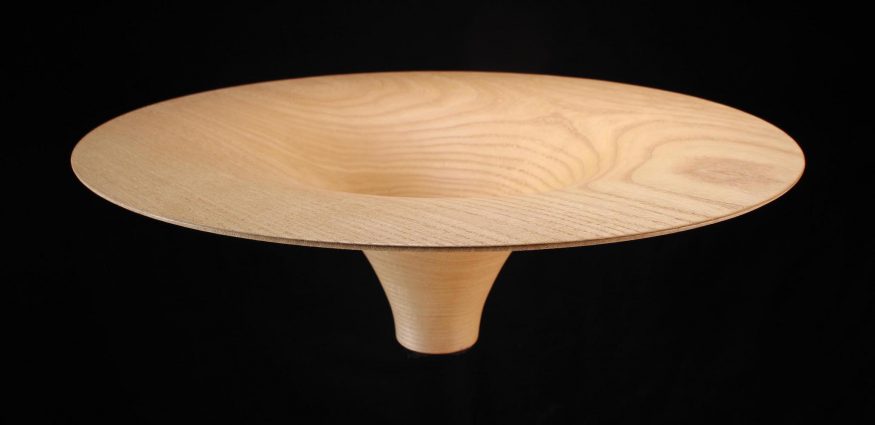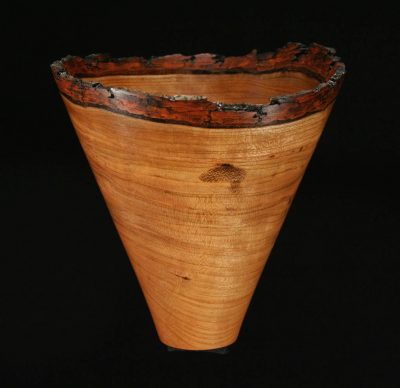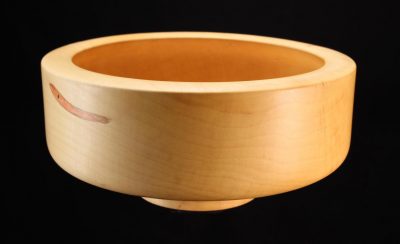Phil Brown’s woodturnings reside in permanent collections in museums throughout the county, including the Smithsonian’s Renwick Gallery and the Museum of Fine Arts in Boston. Yet this acclaimed Bethesda artist continues to turn out masterpieces as Christmas and birthday gifts.
 [/media-credit] Man at work: Woodturner Phil Brown plies his craft.
[/media-credit] Man at work: Woodturner Phil Brown plies his craft.
Like most artists, Brown is not in it for accolades—such as the recent Lifetime Impact Award bestowed upon him in November at the 2017 Montgomery County Executive’s Awards for Excellence in the Arts and Humanities. He unassumingly began his craft making furniture as a teenager in the 1950s in Denver, Colorado. He and his mother cut, so to speak, a deal: she would buy the wood so he could turn it into furniture — usually with a Scandinavian modern flair. Brown retains some of that furniture to this day.
Brown’s vocation includes trees, too. The bulk of his career was spent as an agricultural economist for the U.S. Department of Agriculture. During this time, he shelved woodworking and raised a family. A friend’s offer of some apple tree wood brought him to the lathe, initiating an avocation as a self-taught wood turner. He drew inspiration from contemporary sculptors Isamu Noguchi, Constantin Brancusi, Henry Moore, Barbara Hepworth and Wharton Esherick, as well as pioneer wood turner Bob Stocksdale.
It all starts with a chainsaw, said the artist, who is known for his fine finishes and thinly turned open forms. “I mostly use local wood [I obtain myself] or that is already cut up by a tree service,” he said, explaining, “I decide what shape vessel to create from the wood, such as a natural edge or bark edge at the top of the piece, or a flare or a more typical bowl shape.”.
 [/media-credit] “Paulownia,” 6-¾ by 19 inches, by Phil Brown
[/media-credit] “Paulownia,” 6-¾ by 19 inches, by Phil Brown
Then to the band saw. Brown cuts a circle from a raw block of wood, and mounts it on a lathe. As it turns, and with a tool rest, a gouge cuts away the wood he doesn’t want. “If this is fresh wood, it is [then] waxed to slow the drying and prevent cracking,” he said.
After drying for a year or two — yes, a year or two — the piece is turned thinner to a half-inch thickness, removing the wax and making it round. Brown then treats the wood with an epoxy paint to uniformly harden the wood and the soft spots. This also brings out the natural color.
 [/media-credit] “Black Cherry,” bark on edge, 6 by 6-1/2 by 6 inches, by Phil Brown
[/media-credit] “Black Cherry,” bark on edge, 6 by 6-1/2 by 6 inches, by Phil Brown
“Assuming that I select to finish the piece [into a bowl], it is turned even thinner (to 3/16 of an inch), sanded, epoxy treated again, oiled or lacquered, rubbed smooth, and held in inventory for an exhibit, sale or gift,” Brown said.
The woodturner’s creations travel in many directions from his workshop. “I’m known to major local collectors, a few people occasionally buy a second and third piece, or they commission pieces from [a tree on their property] or a historic tree,” Brown said. There are about five internationally-known woodturning collectors in the D.C. area. But his biggest collectors are his two daughters, who, Brown said, have the largest collections and ask for a piece each birthday or holiday.
Brown used to sell his work in galleries throughout the county, but that changed roughly a decade ago when the economy turned, and many gallery owners closed up shop. Now, he sells through local exhibits and directly to collectors. As for pricing his work, that can be a struggle, as price “has to do with the quality and appearance of the wood. I have a price in mind for an oil finish, and double it for an epoxy or lacquer finish,” he said.
 [/media-credit] “Box Elder,” 5 by 11 inches, by Phil Brown
[/media-credit] “Box Elder,” 5 by 11 inches, by Phil Brown
Sometimes art doesn’t go as planned. What happens to “discards” or “seconds”? “After a piece is first treated with epoxy paint, which indicates how it will turn out, I don’t finish it if it looks poorly, and occasionally [will] throw it out,” Brown said. “Sometimes a finished one does not look good design-wise, or for some other reason…. These, I put a low price on for a retail show, and occasionally they sell, much to my surprise…. Or, I’ll give those to young grandchildren, or they just sit on the shelf.”
Brown said the highlights of his woodturning career include sales “to major turned wood collectors and having pieces given to museums” where they sit as eloquently as they do in public library display cases and in his home.
Another notable achievement: founding the Montgomery County Woodturners — a local chapter of the American Association of Woodturners. This group of turning enthusiasts meets monthly in Rockville and “provides camaraderie and education through demonstrations and discussions…” The group ranges from experts to novices. Asked if he teaches his craft to others, Brown said, candidly, “I can, but I don’t really like to…. I helped form Montgomery County Woodturners to perform that role.”
Finally, given the length of the process from board to bowl, when does Brown consider a piece truly done? ‘A piece is done when it looks good…and when it is what I expect it to look like,” he said.
For information about Montgomery Woodturners, visit http://montgomerycountywoodturners.org.
What a wonderful story about an excellent woodturner. You're an inspiration to all wooodturners.
What a wonderful story about an excellent woodturner. You're an inspiration to all wooodturners.
View less